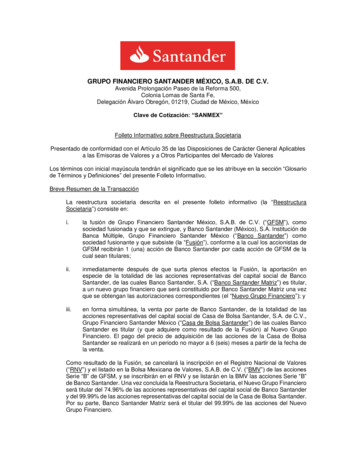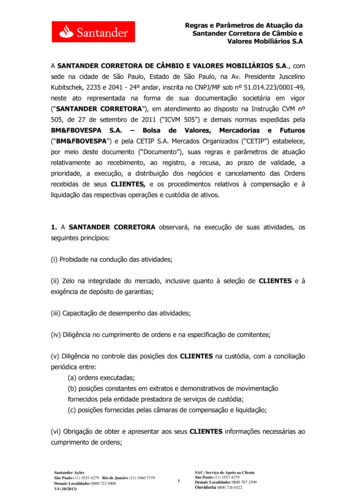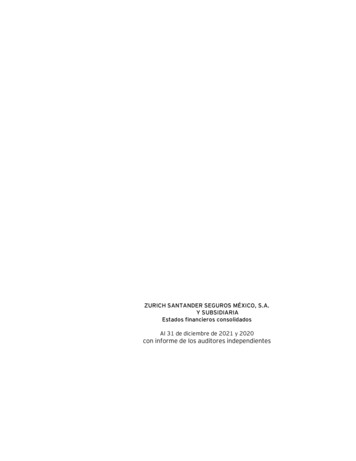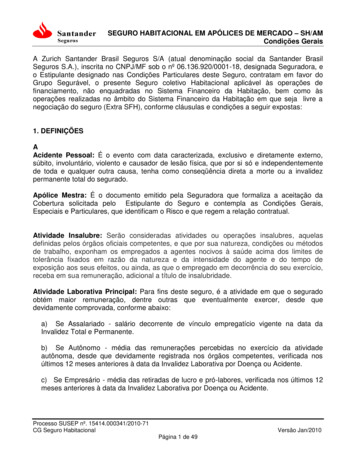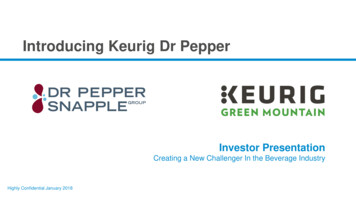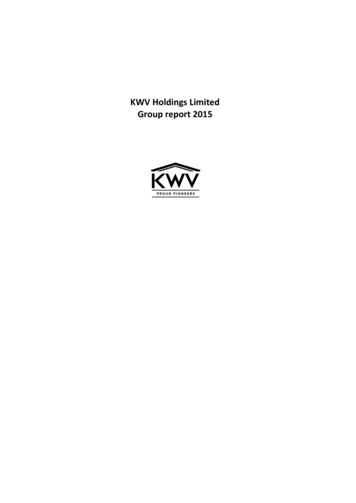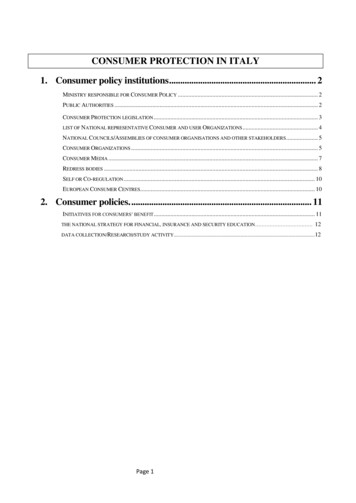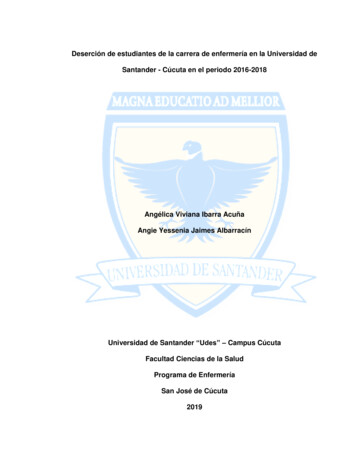
Transcription
Santander Consumer USA Holdings Inc.First Quarter 2017 Earnings CallApril 26, 2017
Santander Consumer USA Holdings Inc. – First Quarter 2017 Earnings Call, April 26, 2017CORPORATE PARTICIPANTSEvan Black, Vice President, Investor RelationsJason Kulas, President and Chief Executive OfficerIsmail “Izzy” Dawood, Chief Financial OfficerCONFERENCE CALL PARTICIPANTSJohn Hecht, JefferiesJack Micenko, SIGMark DeVries, BarclaysJeff Adelson, Morgan StanleySteven Kwok, KBWEric Wasserstrom, Guggenheim SecuritiesDavid Ho, Deutsche BankMoshe Orenbuch, Credit SuisseChris Donat, Sandler O’NeillCharles Nabhan, Wells FargoPRESENTATIONOperator:Good morning and welcome to the Santander Consumer USA Holdings First Quarter 2017 EarningsConference Call. At this time all parties have been placed into listen-only mode. Following today’spresentation the floor will be open for your questions. Please dial star, one to enter the Q&A queue.It is now my pleasure to introduce your host Evan Black, Vice President of Investor Relations. Evan, thefloor is yours.1ViaVid has made considerable efforts to provide an accurate transcription, there may be material errors, omissions, or inaccuracies in thereporting of the substance of the conference call. This transcript is being made available for information purposes only.1-888-562-0262 1-604-929-1352 www.viavid.com
Santander Consumer USA Holdings Inc. – First Quarter 2017 Earnings Call, April 26, 2017Evan Black:Good morning and thank you for joining the call. On the call today we have Jason Kulas, President andChief Executive Officer, and Izzy Dawood, Chief Financial Officer.Before we begin, and as you are aware, certain statements made today such as projections for SC’sfuture performance are forward-looking statements. Actual results could be materially different from thoseprojected. SC has no obligation to update the information presented on the call. For further informationconcerning the factors that could cause these results to differ, please refer to our public SEC filings.Also on today’s call, our speakers may reference certain non-GAAP financial measures that we believewill provide useful information for investors. A reconciliation of those measures to US GAAP is includedin the release issued today, April 26, 2017For those of you listening to the webcast, there are a few user-controlled slides to review as well as a fullInvestor Presentation on the website.I’ll turn the call over to Jason Kulas. Jason?Jason Kulas:Thank you and good morning everyone. Today I’ll discuss our first quarter highlights and provide anupdate on our key strategic priorities. I’ll then turn the discussion over to Izzy for a detailed review of thequarter’s results, and then open the call for questions.Turning to Slide 3 to share some of the key highlights from the first quarter of 2017, we are pleased toreport solid results for the first quarter of 2017. Our assets are producing solid risk adjusted cash flows.Our capital base is solid and our focus on keeping our business simple, personal and fair is positioning usfor continued success.During the quarter, SC earned net income of 143 million or 0.40 per diluted common share. Netincome was impacted by a few unique items this quarter, including accrued interest related to TDR loans,writedowns on loans in bankruptcy and expenses. Izzy will discuss these items during his more detailedcommentary on Q1 performance.Return on average assets for the quarter was 1.5%. Auto originations including loan and lease totaled 5.4 billion this quarter, down from the prior year quarter due to our disciplined underwriting standardsand a competitive market. During the first quarter we executed an agreement to flow prime retail loans toBanco Santander. We expect this strategy to further strengthen our relationship with FCA and positivelyinfluence Chrysler Capital by providing a stable framework for originations.Our track record of rating agency upgrades continued, demonstrating the strength of our ABS platforms.In total, 49 ABS tranches were upgraded this quarter, positively impacting more than 4 billion insecurities.Turning to Page 4, here are some key economic indicators that influenced our originations and creditperformance. US auto sales remain elevated but are ticking down versus recent highs, and consumerconfidence remains high. US GDP growth is in line with the recent historical range and unemploymentlevels continue to be very low. These metrics are strong indicators of the health of the economy and theUS consumer.2ViaVid has made considerable efforts to provide an accurate transcription, there may be material errors, omissions, or inaccuracies in thereporting of the substance of the conference call. This transcript is being made available for information purposes only.1-888-562-0262 1-604-929-1352 www.viavid.com
Santander Consumer USA Holdings Inc. – First Quarter 2017 Earnings Call, April 26, 2017On Page 5 there are a few key factors that can influence our loss severity and credit performance. Asexpected, our auction only recovery rates are trending down and in line with the NADA trends. However,auction plus recovery rates, which include insurance proceeds and bankruptcy and deficiency sales, areonly slightly down versus the first quarter of 2016. We continue to model lower recovery assumptionsthan current experience and believe we are adequately reserved. Additionally, non-prime industrysecuritization data, including delinquency and loss, show these trends are relatively stable to moderatelyhigher. In either case, SC auto ABS remains structurally sound.Turning to Page 7, in March we executed an inaugural transaction for approximately 700 million primeretail loans with Banco Santander. We expect this strategy to support Chrysler Capital by providing amore stable framework for Chrysler Capital originations. This will in turn also be supportive to ourServiced for Others strategy through more prime asset sales. The two-year agreement will also provideSC with 750 million in additional capacity to fund originations between transactions. This warehouseagreement closed in April, bringing our related party funding commitment to approximately 7.7 billion, upfrom 7 billion as of March 31, 2017.Turning to Page 8, auto originations during the quarter totaled 5.4 billion, down 21% from the prior yearquarter. Originations with FICO scores below 640 in our core and Chrysler Capital channels decreased16% and 33%, respectively, versus the prior year quarter. Core originations increased 9% quarter-overquarter and Chrysler Capital loans above 640 decreased 42%, and leases were flat versus the prior yearquarter.Regarding our direct to consumer platform, volume through our Road Loans channel totaled 53 millionthis quarter, up slightly versus the prior year quarter. This online portal has been additive to applicationvolume and we expect Road Loans to be incremental to our originations as the market evolves.We are committed to booking loans with attractive risk adjusted returns that will perform through cyclesand create shareholder value. In our efforts to find pockets of value, we saw a moderate increase in nonprime originations in both our core and Chrysler channels quarter-over-quarter, which has continued intoApril.Turning to Slide 9 and further drilling down into our originations mix, in the first quarter the mix of ouroriginations was relatively constant on a percentage basis. Loans with FICO scores below 640decreased approximately 840 million to 2.7 billion, from 3.5 billion during the prior year quarter. Inaddition, the average loan balance has decreased due to a larger percentage of used vehicles and lowerloan to values, reflecting credit discipline.Now moving to Slide 10, the Chrysler Capital penetration rate as of March 31 was 19%, up from 17% inDecember. We remain the largest finance provider for FCA. Chrysler Capital is a focal point of ourstrategy and we continuously seek out ways to enhance and grow our relationship with FCA.We remain focused on three key strategies, including, first, we’ve increased the number of ChryslerCapital dealers in our VIP program and we are still on track to roll this program out to all FCA dealers in2017. This improves our ability to book standard rate transactions.Second, our dealer floorplan strategy with Santander Bank NA continues to grow. We have increasedour dealer receivables originations by 44% compared to the prior year quarter after a year of strongoriginations growth in 2016.Finally, the Banco Santander flow agreement, as I mentioned previously. It’s also important to note thatour Chrysler Capital volume and penetration rates are influenced by strategies implemented by FCAincluding produce mix and incentives.3ViaVid has made considerable efforts to provide an accurate transcription, there may be material errors, omissions, or inaccuracies in thereporting of the substance of the conference call. This transcript is being made available for information purposes only.1-888-562-0262 1-604-929-1352 www.viavid.com
Santander Consumer USA Holdings Inc. – First Quarter 2017 Earnings Call, April 26, 2017Turning to Slide 11, while still a differentiator for our business, our Serviced for Others balance continuesto decrease due to lower prime originations and lower asset sales. Servicing fee income totaled 32million this quarter as we continue to deliver value through this capital efficient platform. Moving forward,we expect to drive the Serviced for Others platform by increasing our Chrysler Capital penetration throughthe execution of the flow agreement with Santander.I would like to turn now to Izzy for a review of our financial results. Izzy?Ismail “Izzy” Dawood:Thank you, Jason, and good morning everyone. As Jason mentioned, there are some specific items I willdiscuss in more detail, which I also mentioned in our call last quarter.As we continue to remediate our material weaknesses and address qualitative findings in CCART and ourfed written (phon) agreement, we are also aligning several practices to reflect FFIEC guidelines andperformance of certain vintages. One of these changes related to bankruptcy accounts increased our netcredit loss by 24 million which was offset by 9 million lower allowance for credit loss, and decreasedour pre tax income this quarter by approximately 16 million. This impact is timing related, by which Imean it would have been incurred in future periods but was accelerated into this quarter.Separately, we are taking a more conservative approach to the accrual of interest for certain TDR loans.This change does not impact the bottom line but reduced net interest income by 26 million and wascompletely offset by lower TDR impairment, and is reflected in allowance for credit loss. I will cover thesepoints again in their respective slides.Let’s turn to Slide 12 to review this quarter’s results. Net income for the first quarter was 143 million or 0.40 per diluted common share. Net leased vehicle income increased 18% as we continue to seegrowth in our leasing portfolio with FCA. Total Other Income this quarter was 55 million, which is net ofapproximately 65 million of lower of cost or market adjustments related to personal lending, and 12million in other losses that I will detail on a subsequent slide.Moving on to Slide 13 which highlights our performance excluding the impact of personal lending. Furtherdetails can also be found in the appendix of the presentation. Interest on finance receivables and loansdecreased 6% year-over-year due to a mix shift in the portfolio towards higher credit quality assets withlower APRs and lower interest income accrual for specific categories of TDR loans. During the firstquarter we shifted to a more conservative approach related to the accrual of interest for certain TDRloans, and the approximate impact to the top line was 26 million. As I mentioned previously, this iscompletely offset in our allowance for credit loss. As it reduces the carrying value of the loans andtherefore requires lower impairment, this is also reflected in a lower TDR allowance ration this quarter.Interest expense increased 25% versus the prior year quarter, driven by the increase in benchmark rates.One month LIBOR increased more than 50 basis points from March 2016 to March 2017. Cost of fundsof third party amortizers and warehouses increased approximately 60 basis points versus the first quarter2016. Cost of funds in newly issued term ABS improved approximately 30 basis points due to spreadtightening partially offset by benchmark rate increases. Similar to last quarter, these increases werepartially offset by interest rate derivatives.Servicing fee income decreased 29% year-over-year due to lower balances and a change in the creditmix of the Serviced for Others portfolio. Average gross retail installment contract balances were flat yearover-year. Leased assets were up 20% year-over-year and are expected to remain flat for theforeseeable future as our new originations are in line with lease terminations.4ViaVid has made considerable efforts to provide an accurate transcription, there may be material errors, omissions, or inaccuracies in thereporting of the substance of the conference call. This transcript is being made available for information purposes only.1-888-562-0262 1-604-929-1352 www.viavid.com
Santander Consumer USA Holdings Inc. – First Quarter 2017 Earnings Call, April 26, 2017Turning now to Slide 14, we will further drill down into Total Other Income. Reported Total Other Incomewas 55 million in the first quarter 2017. The impact of lower of cost or market adjustments for personallending of 65 million include 111 million in customer defaults offset by a net reduction of marketdiscounts of 47 million as balances decreased versus the prior quarter, in line with seasonal patterns.Normalized investment losses for the quarter were 12 million, primarily driven by losses on asset salesand customer defaults associated with auto assets held for sale. After including servicing fee income andfees, commissions and other, normalized Total Other Income was approximately 120 million.Turning out attention to provisions and reserves on Page 15, at the end of the first quarter 2017 theallowance figure totaled 3.5 billion, up 31 million from the end of the prior period. Drivers of theincrease include 171 million associated with new originations, 128 million due to troubled debtrestructuring or TDR migration, meaning the additional allowance coverage required for loans that nowqualify for TDR treatment per our definition which we are not classified as TDRs during the prior period,and 10 million due to performance adjustments. These are partially offset by 278 million in liquidationswhich includes paydowns and charge-offs. As we discussed at our Investor Day, TDRs are anaccounting classification for assets that meet certain loan modifications or extension criteria. Our LoansServicing team uses loan modifications and extensions on a case by case basis to offer assistance tosome customers experiencing temporary financial hardship. Under GAAP, the allowance requirement onan asset classified as a TDR takes into consideration lifetime losses and even if the loan performs it willcontinue to be classified as a TDR for the remainder of its life.The allowance to loans ratio was 12.7% as of the end of this quarter, up from 12.6% at the end of theprior period. The primary drivers were increases in TDR balances and a denominator effect of slowerportfolio growth. As I mentioned earlier the allowance of credit loss includes the reduction ofapproximately 26 million related to TDR interest accrual and 9 million related to accelerated chargeoffs.Continuing to Slide 16, delinquency rates, delinquency rates including the 31 to 60 and 61-plus bucketsincreased 40 and 80 basis points, respectively, from the prior year quarter. Retail installment grosscharge-off increased 180 basis points and net charge-offs increased 120 basis points. The net charge-offratio increased to 8.8% this quarter, up from 7.6% during the same period last year. The increases inboth of these ratios were driven by the aging of the more non-prime 2015 vintage and overall portfolioageing. As an example, in the current quarter, the 2015 vintage was approximately 30% of our loansoutstanding, but contributed 35% of our losses. Additionally, portfolio ageing driven by lower originationsdecreases the denominator of this ratio and decreases the balances of loans in the numerator that arenewer and have not yet experienced delinquency or charge-offs. Losses were also impacted this quarterdue to writedowns of loans in bankruptcy which I will cover further on the following slide.Recovery rates, as expected, increased from the prior quarter but decreased year-over-year. Wecontinue to see a bifurcation in performance between sedans and larger vehicles such as SUVs andtrucks, which have performed better but still continue to face declines in value.Turning to Page 17 to review the loss figures in dollars. Net charge-offs in our auto loan portfolio forindividually acquired retail installment contracts increased 59 million to 599 million. This quarter weaccelerated approximately 24 million in losses attributable to assets which are written down upon receiptof a bankruptcy notice. The majority of these losses would have been otherwise occurred later in theyear and do not alter our overall view of losses for the year but rather represent a timing impact for Q1.Another 19 million of the overall increase is due to portfolio growth, ageing and mix shift. The primarydriver was portfolio ageing as the average unpaid principal balance was relatively flat versus prior yearquarter. Recoveries were also lower this quarter by approximately 19 million and bankruptcy deficiencysales increased versus the prior year quarter by approximately 15 million.5ViaVid has made considerable efforts to provide an accurate transcription, there may be material errors, omissions, or inaccuracies in thereporting of the substance of the conference call. This transcript is being made available for information purposes only.1-888-562-0262 1-604-929-1352 www.viavid.com
Santander Consumer USA Holdings Inc. – First Quarter 2017 Earnings Call, April 26, 2017Turning to Slide 18, operating expenses this quarter totaled 305 million, an increase of 5% versus sameperiod last year. This increase was driven by continued investment in Compliance and Control functionsand severance expense related to efficiency efforts. The expense ratio for the quarter totaled 2.4%, upfrom 2.2% in the prior year quarter.Turning to Slide 19, total committed liquidity increased 5% to 41.4 billion at the end of the quarter versusprior quarter end. During the quarter we executed two DRIVE and one SDART securitization totalingapproximately 3.1 billion. As with our other DRIVE and SDART non-prime securitizations, these typicallyremain on our balance sheet and we retain the first plus position. Also during the quarter, 49 ABStranches were upgraded, positively impacting more than 4.2 billion in securities. Also, this quarter weincreased unused capacity in our revolving facilities by approximately 1.9 billion and remain confident inour overall liquidity position.Asset sales in the quarter totaled 931 million driven by our new agreement with Banco Santander.Briefly turning to Page 20, our CET1 ratio for this quarter is 13.8% which is 170 basis points higher thanfirst quarter 2016.Looking ahead to Q2, my comments will be relative to Q1 unless otherwise noted, relative to Q1 2017unless otherwise noted, and will include the impact of personal lending, unlike prior quarters when weexcluded personal lending. The personal lending assets remain on the balance sheet and are stillclassified as held for sale. We will update our comments, if necessary, based on any developments inour sale process.We expect net interest income to be down 5% to 7% in the second quarter due to credit mix, lowerinterest accrual on TDR loans and a smaller balance sheet. Also, lease assets are expected to be flatnext quarter relative to first quarter 2017. We expect our allowance for credit losses to be down 20million to 40 million. Net charge-offs are expected to be 130 million to 150 million lower as the secondquarter is seasonally our best performing quarter. Therefore, incorporating the outlook on net charge-offsand allowance for loan loss, overall provision expense is expected to be 180 million to 220 million lowerthan Q1 2017.Other Income is expected to be 30 million to 40 million lower, primarily due to customer defaults inBluestem, held for sale assets, lower servicing fees driven by lower managed assets, and changes inconsumer practice.Operating expenses are expected to be down 5 million to 10 million.Before we begin Q&A, I would like to turn the call back over to Jason. Jason?Jason Kulas:Thanks, Izzy. During the quarter we continued to make progress on strengthening our culture ofcompliance and enhancing our consumer practices with several notable changes which Izzy brieflyreferenced regarding fees. In order to be more simple, personal and fair with our customers, SC nowprovides more free ways to pay or methods for our customers to make payments without payment fees.In addition, beginning on April 1, and in order to align with industry best practices, SC will no longeraccept credit cards, which in the past carried higher fees. We have also reduced the fee to pay with debitcards.We are also focused on continuing to improve our customer experience with a pipeline of other consumerinitiatives including a look at our customer statements and more financial education for our customers so6ViaVid has made considerable efforts to provide an accurate transcription, there may be material errors, omissions, or inaccuracies in thereporting of the substance of the conference call. This transcript is being made available for information purposes only.1-888-562-0262 1-604-929-1352 www.viavid.com
Santander Consumer USA Holdings Inc. – First Quarter 2017 Earnings Call, April 26, 2017they can have more insight into the status of their loan and how late payments impact their status. Welook forward to sharing updates on these topics in future discussions.Finally, during the quarter we launched a new complaints management strategy which we expect toenhance our ability to identify and address root causes of complaints, and put us in a position to betterserve our customers.Finally, in response to several investor inquiries regarding dealer management and monitoring followingthe recent settlement with Massachusetts and Delaware, we have included two slides in the appendix ofour presentation this quarter. These slides provide additional color on our Dealer Services team and theevolution and enhancements to our dealer performance management program over the past severalyears. This slides (inaudible) of our dealer oversight and monitoring efforts. As the industry continues tofocus on this area, we are committed to be leaders in dealer management, moving beyond the traditionalmethods of monitoring credit performance.We believe there’s a direct connection between strong consumer practices, a culture of compliance andthe creation of shareholder value. Simply stated, the companies that embrace and execute on theseconcepts will be more successful than those who do not. In 2017, SC will drive value through enhancingcompliance controls and consumer practices, continued credit discipline, diverse and stable sources ofliquidity, industry leading efficiency and technology, a focus on recognizing upside in Chrysler Capitalthrough dealer VIP, floorplan and the Santander flow program, and finally, being simple, personal and fairwith our customers, employees in all constituencies.With that, I’d like to open the call for questions. Operator?Operator:Hello. We will open the call for questions. Please limit yourself to one question and one follow-upquestion. Thank you.Our first question comes from John Hecht with Jefferies. Please proceed with your question.John Hecht:Hey guys, thanks very much. A real quick question. Just there’s a lot of moving parts with respect to thetrajectory of your allowance. You’ve got TDR migration with the ’15 vintage that should be alleviatingover the year, you’ve got a tightening credit book with newer originations. How should we think about thetrajectory to ALL over the year given those factors.Ismail “Izzy” Dawood:Sure. John, I’ll take that and then Jason will chime in. First of all, I think we’re seeing what we expected,the growth in TDRs, even though it’s occurring it’s growing at a slower pace. We remain comfortablesaying TDRs will peak late 2017, early 2018 based on everything we’re seeing. That’s the first item.The second item, if the credit mix of our origination holds true in what we see, overall timing of provisionsby math and intuition, provisions should come down. It’s just a timing of that decrease in provisions can’tbe exactly pinpointed, but I think, as I said, if everything continues the way we’ve been seeing and whatwe’re experiencing, we should see that allowance level get lower.John Hecht:Okay. Is that sort of linear downtick or is there some seasonality we should think about there?7ViaVid has made considerable efforts to provide an accurate transcription, there may be material errors, omissions, or inaccuracies in thereporting of the substance of the conference call. This transcript is being made available for information purposes only.1-888-562-0262 1-604-929-1352 www.viavid.com
Santander Consumer USA Holdings Inc. – First Quarter 2017 Earnings Call, April 26, 2017Ismail “Izzy” Dawood:Like I said, John, from a quarterly basis it’s tough to pinpoint. It’s really not seasonality; it’s more aboutthe overall—two things: one, the overall change in credit mix of our portfolio as 2015, more non-primevintage runs off; and second, just over the last several quarters the overall portfolio growth has slowed.That’s the other driver of the overall allowance level.John Hecht:Okay. That’s helpful. Thanks. Then second question is we’ve heard some banks talk about pulling back.You guys have alluded to some improvements in certain components to the competitive market. I wonderif you can give us a little bit more deep dive there. What are you seeing? At what point do you thinkyou’ll be able to both tighten and take back share? You know, where are we in the overall cycle?Thanks.Jason Kulas:What we typically talk about is kind of the top 20 or so lenders versus the rest of this fragmented marketthat we operate in, and a couple of observations there. If you look at the all-in retail market, what we’reseeing is the top 20 lenders are still incrementally losing share to everyone else, but if you drill down intoprime versus non-prime, that story is still true for prime. The prime and near-prime parts of the businessremain extremely competitive and the top lenders are continuing to incrementally lose share to everyoneelse. But it’s not true in non-prime where we’ve seen—again, these are incremental shifts but anincremental pick up in the top 20’s overall share of non-prime versus everyone else, and I think you seethat reflected in our originations where we’re factoring in what we see to what we originate, and we’regetting incrementally more of it relative to the past couple of quarters. Relative to this time last year,we’re still getting significantly less, so we’re still in a very competitive market, and that’s the reason wekeep stressing this word incremental. But, we are seeing that competition has declined maybe slightly innon-prime, allowing some of the larger lenders to get a little bit more of that share on terms that a larger,more sophisticated lender would think make sense.So, you know, I’d say again, these shifts are very minor shifts. What we see is what we’ve been seeing,which is it’s a very competitive market. Cost of funds is still very low. Availability of liquidity is still veryhigh and we’re factoring in everything we see into new originations and I think you see that reflected inthe quality of what we’re putting on the books right now.John Hecht:Great, guys. Appreciate the color, thanks.Jason Kulas:Sure.Operator:Our next question is from Jack Micenko with SIG.Jack Micenko:Hey, good morning guys. First question, a follow-up on that first one. We’ve seen certainly in the primeworld and then maybe a few on the non-prime, some modest uptick in pricing in the last couple of quarter.I think, Jason, it’s consistent with what you’re saying but I guess my question would be are you seeingless competition through more rational pricing of the loans or are you just seeing less providers out there?8ViaVid has made considerable efforts to provide an accurate transcription, there may be material errors, omissions, or inaccuracies in thereporting of the substance of the conference call. This transcript is being made available for information purposes only.1-888-562-0262 1-604-929-1352 www.viavid.com
Santander Consumer USA Holdings Inc. – First Quarter 2017 Earnings Call, April 26, 2017Jason Kulas:We haven’t seen rationalization in numbers of competitors. We do talk from time to time about howlonger term we actually expect that to happen. This is more about how people are pricing and structuringloans, different ways to put in prices, not just APR. You can advance more or less and those kinds ofthings.I can speak obviously the most about what we do and what we’re seeing is that we’re being moreconservative on payment to income ratios. We’re being more conservative on loan to values. Our terms,our contractual terms are relatively flat and with that approach we’re getting volume that we think makessense; significantly down year-over-year but a little bit more sequentially.In terms of pricing going up in the market, that’s not a big surpris
Charles Nabhan, Wells Fargo P R E S E N T A T I O N Operator: Good morning and welcome to the Santander Consumer USA Holdings First Quarter 2017 Earnings . influence Chrysler Capital by providing a stable framework for originations. Our track record of rating agency upgrades continued, demonstrating the strength of our ABS platforms.
